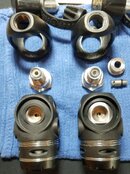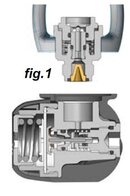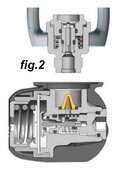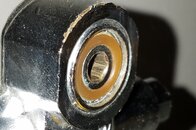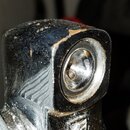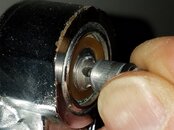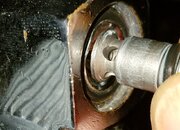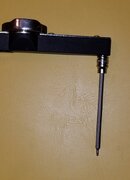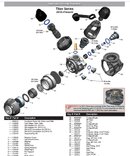Thank you! It is wonderful that you have been able to pry out the truth of the matter from the sources you have. That explanation makes some sense if one has only a very shallow depression between the face of the valve and the slightly loosened shutter valve. You seem to be telling us that an inadequately torqued shutter valve can lead to unscrewing of the valve, with subsequent metal to metal sealing against the valve output area. As I look at various valves in my collection, there seem to be two distinct variants, only one of which is at risk.
The following photos show an insert valve with a very shallow face, vs a classic yoke valve with a conical depression.
View attachment 485826 View attachment 485827
When I place a shutter valve against both valves, the insert valve is completely obscured, while the conical valve would require excessive loosening of the shutter valve, and its oring would probably leak or the valve would come apart. At minor loosening, there is likely still an airflow gap. The recommended check of the ACD should show the problem.
View attachment 485828 View attachment 485829
What remains perplexing is the cause of that square-wave shutoff noted by
@databob at 900 psi. It suggests some change in the geometry due to a combination of spring pressure and hydrostatic pressure on the back of the shutter crown. And that still doesn't make sense to me. But in any case, it will be interesting if
@databob can supply info regarding the type of valve with which the problem arose. If it was a rental, we're probably out of luck. But maybe it was one of his own tanks? The other thought is regulator rocking while pressurized. If clearance is down to almost nothing, and the shutter valve is loosened, it is conceivable that just a couple of rocks of the reg on the tank valve might unscrew the shutter a hair more. How that might happen during a dive is difficult to visualize, though. No wonder this problem is so rare.
In any case, given the very shallow clearance in the face of the insert valve above, this explanation is much simpler than my original proposition of the valve sealing closed via normal valve function of the shutter crown rising up against the valve. One mm is just too much movement to posit. Occam's razor probably wins again. I couldn't be happier to be wrong.
On the basis of
@JackD342 's information, I guess my thought would be that ACD owners might want to reconsider the use of a shallow faced insert valve like the one I photographed above. There must be vanishingly small clearance between a slightly loosened shutter valve and the tank valve face in a case like that. Then again, just following Aqualung's service bulletin, and ensuring that the shutter valve is torqued appropriately is probably enough. I guess this is one first stage that I
wouldn't run longer than the recommended service interval. And I'd maybe even ask to see the 3mm shop fitting that attaches to a torque wrench before I'd believe a shop's assurances. That's a relatively uncommon tool.
View attachment 485830
Thank you again to
@databob and
@JackD342 for this information.
As for the yoke retainers, if one wanted to downgrade from ACD to non-ACD, I'll try to obtain the Titan part and report back. I'm still unclear how an old fashioned longer filter will be held in place, given the new land in the post-2013 reg body. But I appreciate the suggestion.
More to follow!



